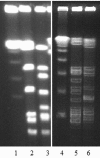Effects of orally administered tetracycline on the intestinal community structure of chickens and on tet determinant carriage by commensal bacteria and Campylobacter jejuni
- PMID: 16204498
- PMCID: PMC1265988
- DOI: 10.1128/AEM.71.10.5865-5872.2005
Effects of orally administered tetracycline on the intestinal community structure of chickens and on tet determinant carriage by commensal bacteria and Campylobacter jejuni
Abstract
There is a growing concern that antibiotic usage in animal production has selected for resistant food-borne bacteria. Since tetracyclines are common therapeutic antibiotics used in poultry production, we sought to evaluate the effects of oral administration on the resistance of poultry commensal bacteria and the intestinal bacterial community structure. The diversity indices calculated from terminal restriction fragment length polymorphism (T-RFLP) analysis of 16S rRNA amplicons did not indicate significant changes in the cecal bacterial community in response to oxytetracycline. To evaluate its effects on cultivable commensals, Enterococcus spp., Escherichia coli, and Campylobacter spp. were isolated from the cecal droppings of broiler chickens. Enterococcus spp. and E. coli expressed tetracycline MICs of >8 microg/ml and harbored a variety of tet resistance determinants regardless of the tetracycline exposure history of the birds. The enterococcal isolates possessed tetM (61%), tetL (25.4%), and tetK (1.3%), as well as tetO (52.5%), the determinant known to confer a tetracycline resistance phenotype in Campylobacter jejuni. E. coli isolates harbored tetA (32.2%) or tetB (30.5%). Tetracycline MICs remained at <2 microg/ml for Campylobacter isolates before and after tetracycline treatment of the chickens, even though isolates expressing MICs of >16 mug/ml were commonly cultured from flocks that did not receive oxytetracycline. The results imply that complex ecological and genetic factors contribute to the prevalence of antibiotic resistance arising from resistance gene transfer in the production environment.
Figures

Similar articles
-
Tetracycline resistance of Australian Campylobacter jejuni and Campylobacter coli isolates.J Antimicrob Chemother. 2005 Apr;55(4):452-60. doi: 10.1093/jac/dki040. Epub 2005 Mar 2. J Antimicrob Chemother. 2005. PMID: 15743900
-
Trends in antibiotic sensitivity pattern and molecular detection of tet(O)-mediated tetracycline resistance in campylobacter jejuni isolates from human and poultry sources.Jpn J Infect Dis. 2008 Jan;61(1):82-4. Jpn J Infect Dis. 2008. PMID: 18219143
-
Prevalence of Campylobacter jejuni and its resistance to antibiotics in poultry in the Czech Republic.Zoonoses Public Health. 2009 Apr;56(3):111-6. doi: 10.1111/j.1863-2378.2008.01176.x. Epub 2008 Sep 2. Zoonoses Public Health. 2009. PMID: 18771516
-
Re-thinking the chicken-Campylobacter jejuni interaction: a review.Avian Pathol. 2018 Aug;47(4):352-363. doi: 10.1080/03079457.2018.1475724. Epub 2018 Jun 11. Avian Pathol. 2018. PMID: 29764197 Review.
-
Antimicrobial resistance in selected bacteria from poultry.Anim Health Res Rev. 2008 Dec;9(2):149-58. doi: 10.1017/S1466252308001552. Anim Health Res Rev. 2008. PMID: 19102788 Review.
Cited by
-
Successional changes in the chicken cecal microbiome during 42 days of growth are independent of organic acid feed additives.BMC Vet Res. 2014 Nov 27;10:282. doi: 10.1186/s12917-014-0282-8. BMC Vet Res. 2014. PMID: 25427406 Free PMC article.
-
Assessing the Effect of Oxytetracycline on the Selection of Resistant Escherichia coli in Treated and Untreated Broiler Chickens.Antibiotics (Basel). 2023 Nov 23;12(12):1652. doi: 10.3390/antibiotics12121652. Antibiotics (Basel). 2023. PMID: 38136686 Free PMC article.
-
Resistance gene transfer during treatments for experimental avian colibacillosis.Antimicrob Agents Chemother. 2012 Jan;56(1):189-96. doi: 10.1128/AAC.05617-11. Epub 2011 Oct 10. Antimicrob Agents Chemother. 2012. PMID: 21986830 Free PMC article.
-
Prevalence, Tetracycline Resistance and Tet(O) Gene Identification in Pathogenic Campylobacter Strains Isolated from Chickens in Retail Markets of Lima, Peru.Antibiotics (Basel). 2022 Nov 9;11(11):1580. doi: 10.3390/antibiotics11111580. Antibiotics (Basel). 2022. PMID: 36358237 Free PMC article.
-
Food animals and antimicrobials: impacts on human health.Clin Microbiol Rev. 2011 Oct;24(4):718-33. doi: 10.1128/CMR.00002-11. Clin Microbiol Rev. 2011. PMID: 21976606 Free PMC article. Review.
References
-
- Aarestrup, F. M., A. M. Seyfarth, H. Emborg, K. Pedersen, R. S. Hendriksen, and F. Bager. 2001. Effect of abolishment of the use of antimicrobial agents for growth promotion on occurrence of antimicrobial resistance in fecal enterococci from food animals in Denmark. Antimicrob. Agents Chem. 45:2054-2059. - PMC - PubMed
-
- Avrain, L., C. Vernozy-Rozand, and I. Kempf. 2004. Evidence for natural horizontal transfer of tetO gene between Campylobacter jejuni strains in chickens. J. Appl. Microbiol. 97:134-140. - PubMed
-
- Bager, F., M. Madsen, and J. Christensen. 1997. Avoparcin used as a growth promoter is associated with the occurrence of vancomycin-resistant Enterococcus faecium on Danish poultry and pig farms. Prev. Vet. Med. 31:95-112. - PubMed
-
- Baron, E. J., L. R. Peterson, and S. M. Finegold. 1994. Enterobacteriaceae, p. 370. In Bailey and Scott's diagnostic microbiology, 9th ed. Mosby, St. Louis, Mo.
-
- Barrett, T. J., H. Lior, J. H. Green, R. Khakhria, J. G. Wells, B. P. Bell, K. D. Greene, J. Lewis, and P. M. Griffin. 1994. Laboratory investigation of a multistate food-borne outbreak of Escherichia coli O157:H7 by using pulsed-field gel electrophoresis and phage typing. J. Clin. Microbiol. 32:3013-3017. - PMC - PubMed
Publication types
MeSH terms
Substances
LinkOut - more resources
Full Text Sources
Other Literature Sources
Medical
Molecular Biology Databases
Miscellaneous

